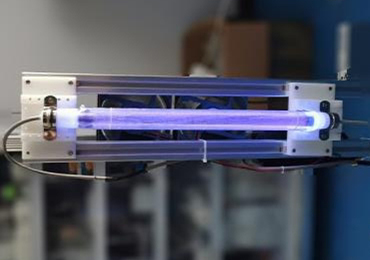

Critical medical and surgical devices enter parts of the body tissue which are usually sterile or pertain to the flow of sterile bodily fluids, such as blood and urine.įiltered 200–230 nm far UV-C wavelengths offer protection and disinfection Within healthcare practices, equipment sterilisation is a mandatory process which must take place before every use.

Sterilisation kills, eradicates, and / or inactivates biological lifeforms such as bacteria, fungi, viruses, endospores, and prions. Sterilisation is a process in which all pathogenic microorganisms, including vegetative endospores, are completely destroyed.
FAR UVC LAMP SKIN
High-level disinfection must be implemented on semi-critical equipment which comes into direct contact with mucous membranes or non-intact skin this includes devices such as endoscopes and respiratory therapy equipment. In a hospital scenario, low-level disinfection is implemented on non-critical surfaces and equipment which come into contact with intact skin, such as bed frames or the inflatable cuff of a blood pressure monitor. Various methods of disinfection are commonly used throughout daily life, mostly for the acceptable decontamination of surfaces and air. Disinfection is ineffective against bacterial endospores despite being able to remove pathogens, which is what separates this type of cleaning from sterilisation. The definition of disinfectionĭisinfection is a process in which the number of pathogenic microorganisms, such as viruses and bacteria, is reduced through inactivation. While many people regard these terms to be interchangeable, they actually have slightly different meanings pertaining to the level of cleanliness achieved. The difference between disinfection and sterilisationĭisinfection and sterilisation are both methods which seek to achieve decontamination through the removal of pathogens. There is no living cell with a total resistance to ultraviolet light, it occurs naturally within the environment, and does not affect the taste or smell of the UVGI treated substance. The use of chemicals is detrimental to the environment, and in most cases, can lose effectiveness over time due to the ability of microorganisms to develop a resistance to them. The catastrophic destruction of their genetic structure renders the pathogenic organisms unable to reproduce or infect and, in some cases, kills them.Īble to neutralise living cells in a matter of seconds, UVGI is an ideal alternative to chemical disinfection. This has a mutagenic effect on organisms by exciting the molecules at the core of their DNA and RNA. UVGI achieves this by disrupting the DNA functions of microorganisms and pathogens such as bacteria, viruses, and protozoa. UV radiation between 160 nm and 310 nm has a unique germicidal ability to act as an effective means of disinfection. In September 2020, the Department of Infectious Diseases at Hiroshima University Hospital confirmed that Care222® lamps are effective against SARS-CoV-2, the virus responsible for the COVID-19 pandemic.


The system has demonstrated its ability to inactivate all kinds of ‘super bugs’ such as MRSA, influenza, MERS-CoV, as well as viruses like Ebola. Ushio has been granted exclusive use of new patented band-pass wavelength filtration technology. The 222 nm irradiation kills bacteria and inactivates viruses without damaging human cells/tissues using narrow-band spectrum UV. Ushio’s longstanding collaborations with respected scientific institutions, such as Kobe University of Japan and the University Hospital of Singapore, have contributed to the development of Care222® technology. With recently completed and ongoing studies taking place, new safe ways are emerging to make Care222® products your best opportunity to secure microbial reduction in occupied spaces too. The system has already been deployed in many unoccupied spaces. UVGI is commonly known as UV disinfection. The Care222® line uses ultraviolet germicidal irradiation (UVGI) to kill bacteria and inactivate a vast range of viruses. Ushio is proud to introduce the Care222® series, a new line of krypton chloride (KrCl) excimer lamps designed for highly-effective microbial reduction.


 0 kommentar(er)
0 kommentar(er)
